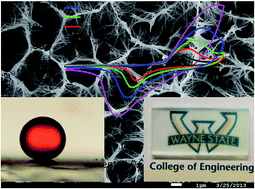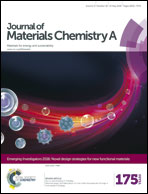Bio-inspired synthesis of α-Ni(OH)2 nanobristles on various substrates and their applications†
Abstract
It is still a challenging task to develop simple methods for facile synthesis of α-Ni(OH)2 nanostructures on substrates under mild conditions without using expensive instruments. Here, α-Ni(OH)2 nanobristles were synthesized on various substrates under mild conditions via a bio-inspired method using a simple Nafion diaphragm-assisted system. By growing the unique networks of α-Ni(OH)2 nanobristles on a piece of glass, a double-rough surface, with structures at both the nanoscale and microscale, was achieved, showing interesting roughness-induced superhydrophobicity in air (water contact angle 156°) and superoleophobicity in water (oil contact angle 161°). Additionally, α-Ni(OH)2 nanobristles could be formed directly on Ni foam and used as integrated and binder-free electrodes for application in supercapacitors. The unique structure with a large exposed surface enables the electrodes to demonstrate an impressive capacity of 2090 F g−1 at a current of 2 A g−1. The α-Ni(OH)2 supercapacitor exhibits a relatively good long cycling performance, attributed to its network like structure and good stability. The method and ideas outlined in the paper, based on diaphragm-assisted systems, could be employed, in principle, for the synthesis of other functional materials or precursors under mild conditions.

- This article is part of the themed collection: Emerging Investigators 2016: Novel design strategies for new functional materials

 Please wait while we load your content...
Please wait while we load your content...